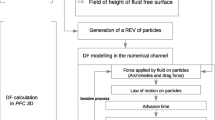Abstract
Cellular automata are good candidates for modelling and simulating complex dynamical systems, whose evolution depends on the local interactions of their constituent parts. Many macroscopic phenomena have such features, but their complexity involves sometime the interaction of heterogeneous processes, whose composition is not immediate in a cellular automaton frame. Furthermore the managing of flows could be not trivial, because cellular automata and derived models as lattice-gas methods cannot always be applied successfully to macroscopic cases. We propose some empirical and practical rules for modelling some macroscopic phenomena with surface flows. An application to complex debris flows is exhibited together with the results of simulations of a real case.
Access this chapter
Tax calculation will be finalised at checkout
Purchases are for personal use only
Preview
Unable to display preview. Download preview PDF.
Similar content being viewed by others
References
von Neumann, J.: Theory of self reproducing automata. Uni. of Illinois Press, Urbana (1966)
Worsch, T.: Simulation of Cellular Automata. FGCS, 16, (1999) 157–170
Toffoli, T., Margolus, N.: Cellular Automata Machines. MIT Press, Cambridge (1987)
Di Gregorio, S., Serra R.: An empirical method for modelling and simulating some complex macroscopic phenomena by cellular automata. FGCS, 16, (1999) 259–271
Barca, D., Crisci, G.M., Di Gregorio, S., Nicoletta, F.P.: Cellular Automata for simulating lava flows: a method and examples of the Etnean eruptions. Transport Theory and Statistical Physics, 231–3 (1994), 195–232
D Ambrosio, D., Di Gregorio, S., Gabriele, S., Gaudio R.: A Cellular Automata Model for Soil Erosion by Water. Physics and Chemistry of the Earth, Vol. 26(1), (2001), pp. 33–39.
Succi, S., Benzi, R., Higuera, F.: The lattice Boltzmann equation: a new tool for computational fluid dynamics. Physica 47 D (1991) 219–230
Cruden, D.M., Varnes, D.J.: Landslide Types and Processes. In: Turner, A.K., Schuster, R.L., (eds.): Landslides: Investigation and Mitigation. Special Report 247, Transportation Research Board, NRC, National Academy Press, Washington D.C., (1996) 36–75.
Di Gregorio, S., Nicoletta, F., Rongo, R., Sorriso-Valvo, M., Spezzano, G., Talia D.: Landslide Simulation by Cellular Automata in a Parallel Environment. Mango Furnari, M.(ed.): Proceedings of 2nd International Workshop “Massive Parallelism: Hardware,Software and Applications”, World Scientific, Singapore (1995) 392–407
Barca, D., Di Gregorio, S., Nicoletta, F.P., Sorriso-Valvo, M.: A Cellular Space Model for Flow type Landslides. In: Messina, G., Hamzda, M.H., (eds.): Computers and their Application for Development. Proc. Int. Symp. IASTED (Taormina), (1986) 30–32
Sassa, K.: Motion of Landslides and Debris Flows. Report for Grant-in-Aid for Scientific Research by the Jap. Ministry of Edu., Science and Culture (Project No. 61480062), (1988).
Segre, E., Deangeli, C.: Cellular Automaton for Realistic Modelling of Landslides. Nonlinear Processes in Geophysics, 2(1), (1995) 1–15.
Di Gregorio, S., Rongo, R., Siciliano, Sorriso-Valvo, M. Spataro, W.: Mt. Ontake landslide simulation by the cellular automata model SCIDDICA-3. Physics and Chemistry of the Earth, 24(2), (1999) 97–100.
Avolio, M.V., Di Gregorio, S., Mantovani, F., Pasuto, A., Rongo, R., Silvano, S., Spataro, W.: Simulation of 1992 Tessina landslide by CA model and future hazard scenarios. JAG, 2(1), (2000)41–50.
Malamud, B.D., Turcotte, D.L.: Cellular Automata models applied to natural hazards. IEEE Computing in Science & Engineering. 2(3), (2000) 42–51
Clerici, A., Perego, S.: Simulation of the Parma River blockage by the Corniglio landslide (Northern Italy). Geomorphology, 33 (2000) 1–23.
D’Ambrosio, D., Di Gregorio, S., Iovine, G., Lupiano, V., Rongo, R., Spataro, W.: First simulations of the Sarno debris flows through Cellular Automata modelling. Geomorphology, (2002) in press.
Del Prete, M., Guadagno, F.M., Hawkins, A.B.: Preliminary report on the landslides of 5 May 1998, Campania, southern Italy. Bull. Eng. Geol. Env. 57, (1998) 113–129.
Author information
Authors and Affiliations
Editor information
Editors and Affiliations
Rights and permissions
Copyright information
© 2002 Springer-Verlag Berlin Heidelberg
About this paper
Cite this paper
D’Ambrosio, D., Di Gregorio, S., Iovine, G., Lupiano, V., Rongo, R., Spataro, W. (2002). Modelling Surface Flows for Macroscopic Phenomena by Cellular Automata: An Application to Debris Flows. In: Bandini, S., Chopard, B., Tomassini, M. (eds) Cellular Automata. ACRI 2002. Lecture Notes in Computer Science, vol 2493. Springer, Berlin, Heidelberg. https://doi.org/10.1007/3-540-45830-1_29
Download citation
DOI: https://doi.org/10.1007/3-540-45830-1_29
Published:
Publisher Name: Springer, Berlin, Heidelberg
Print ISBN: 978-3-540-44304-9
Online ISBN: 978-3-540-45830-2
eBook Packages: Springer Book Archive




